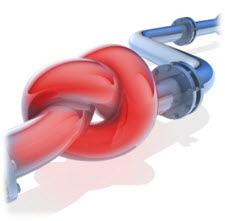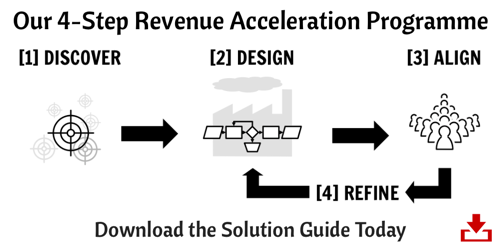Why you don’t need any sales stages in your sales pipeline
June 4, 2015

 The above assertion might appear counter-intuitive, but please bear with me. I’m going to try and make the case that you don’t need - and in fact you shouldn’t have - any sales stages in your sales pipeline.
The above assertion might appear counter-intuitive, but please bear with me. I’m going to try and make the case that you don’t need - and in fact you shouldn’t have - any sales stages in your sales pipeline.
I’m not arguing that you don’t need a sales pipeline. Far from it. The universe would probably grind to a halt if every sales organisation decided to abandon their pipeline. I’m just convinced that there’s a far better way of managing it than by using sales stages.
The alternative? It’s to value your pipeline and measure your progress with reference to the stage your prospects are at in their buying decision process. In other words, you don’t need sales stages - you need buying stages…
The idea of managing the pipeline with reference to the buyer’s journey isn’t a new concept. It dates back at least to Hugh Macfarlane’s ground-breaking book “The Leaky Funnel” which was first published in 2003.
But if ever there was a time to put it into practice, that time is now. More stakeholders than ever are involved in buying decisions - and their numbers are growing. More well-qualified opportunities than ever are ending in “no decision”. B2B buyers are more risk averse than ever.
Given all of these uncertainties and complications, the idea that sales pipelines can best be managed as a succession of completed sales activities has never been less plausible, or less effective - at least in the complex sales environment.
The Forecast Accuracy Challenge
As if we needed any proof, the latest CSO Insights research confirms that sales forecast accuracy on a deal-by-deal basis remains stubbornly stuck below 50%. Tossing a coin would, on average, offer a more accurate prediction.
That’s why tracking the progress of your opportunities with reference to your prospect’s buying decision process is such an important idea. It’s harder to achieve, but resulting increase in the accuracy of pipeline valuations and sales forecasts make it more than worth the effort.
Introducing Buying Process Aligned Sales Pipeline Stages
After modelling the prospect buying decision process for dozens of clients in high-value, multiple stakeholder complex sales environments, a clear pattern has emerged. Your environment may show some subtle variations depending on the nature of your solution, but broadly speaking:
Satisfied with the Status Quo
Prior to the start of the buying process, your prospect is broadly satisfied with the status quo, but they are still interested in trends and issues that may affect their organisation, department or role. This is the perfect point at which to introduce an issue, implication or fresh perspective they may not have been aware of or have previously not given any thought to.
Open to the Possibility of Change [Phase 1]
But then something happens (preferably as a result of your stimulus) - a trigger event that draws their attention to the idea that sticking with the status quo may not, after all, be their best option going forwards. This is the first active phase of their buying decision journey, and an opportunity to shape their early thinking about what may be needed.
Deciding if They Need to Act [Phase 2]
A clear need has been established, and the individual who first identified the issue is typically reaching out to colleagues who may also be impacted. Your prospect (usually by now a group of interested stakeholders, rather than a single individual) is assessing their situation, investigating their options, and trying to decide whether there is a compelling case for change.
Defining their Vision of a Solution [Phase 3]
Having concluded that there is a compelling case for change, your prospect’s attention now turns to defining their requirements, deciding which options to short list, and agreeing the decision team, process, timing and criteria. It’s usually critically important to your chances of success that you are actively involved and influencing their thinking by this stage.
Selecting their Best Option [Phase 4]
Your prospect is evaluating their shortlisted options against the criteria that were decided in the previous phase, reconfirming the business case, and striving to achieve decision team consensus around a single preferred option. Your focus needs not to be just on winning their recommendation - you must also ensure that you reinforce the need to take action. If you first get involved at this stage (for example receiving an RFP that you have not helped to shape), your chances of winning are very slim.
Validating their Decision [Phase 5]
By this stage, your prospect has identified their single preferred solution, and is trying to eliminate any remaining risks or reservations and to negotiate the best possible contractual and commercial terms. It remains possible that they could still either decide to do nothing or to reopen the evaluation of alternative solutions. Depending on the value or the strategic importance of the project, the decision may still have to pass a final investment approval process.
Decision Confirmed and Order Placed
The prospect has decided to act - and preferably chosen your solution. If they have, your focus must now turn to ensuring that they successfully achieve the goals of the project. But whether the outcome is a win, a loss or decision to do nothing, it’s critical that you learn from the process and use the lessons learned to further refine your understanding of how these decisions are made.
Putting the Principle into Practice
When creating models of the buying decision process, it’s easy to assume that the process is linear - but it rarely is. Prospects will often get stuck in stage, or revert to a previous stage as a result of some change in circumstance. It’s also very possible that different members of the decision team may be at different points in their thinking than others. That’s why it’s called a complex sale.
When you think about the evolution of a buying decision from the prospect’s perspective, it becomes obvious that vendors need to engage as early as possible in the decision making process - preferably before the prospect had decided whether they need to act and certainly before they have established their vision of a solution.
Defining your sales pipeline from the buyer’s perspective isn’t as easy as the conventional sales activity based approach. It requires that your sales people pay particular attention to determining where their prospects are in their decision journey, and intelligently adapting their tactics to match their prospects circumstances. It is most effective when sales organisations are focused on early engagement. But the impact - in terms of win rates of properly qualified opportunities - can be profound (I’ve observed 2-3 fold improvements as an average).
The Sting in the Tail
But there is a sting in the tail: almost inevitably, once you make the shift to a buying-stage defined pipeline, many of the opportunities you thought were in your pipeline will either be shown to be at a much earlier stage, or will drop out completely. The apparent value of your pipeline will initially decline. But you can be comforted by the thought that you’ve now shown that those other “opportunities” were never real, anyway.
At least your sales people might now spend less time on opportunities that were never going to close or you were never likely to win. And your success rate in closing the winnable opportunities will more than make up for the difference.
Interested in learning more? You can download a copy of a one-page summary of a buying stage defined pipeline here.
And if you'd like to learn more about taking a structured approach to accelerating revenue growth, please click on the image below...



Comments